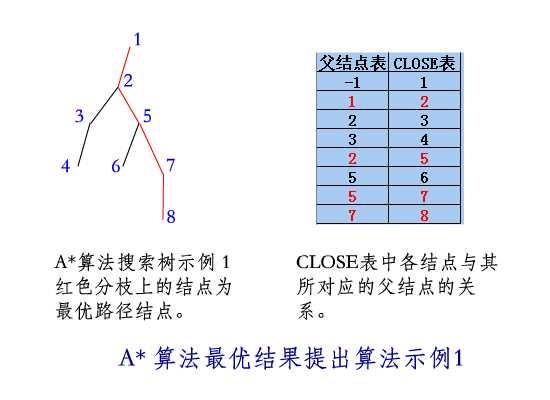A*算法最优解提取算法
EmilMatthew ([email protected])
[ 类别 ]算法,人工智能
[推荐指数]★★★★
[ 摘要 ]本文就“
启发式搜索算法引论
------A*
算法理论与实践
”
一文中的最优解提取算法的不足处进行了改进,提出了一个通用的
A*
算法的最优解提取算法。
[ 关键词 ]
A*
,最优解提取,
AS2
The Algorithm of Best Answer Getting Method in A*
[Classify] Algorithm
, Artificial Intelligence
[
Level
]
★★★★
[Abstract]In my previous passage------”
Introduction to Heuristics Search------A* Algorithm Principle and Practice”, the algorithm for getting out the best answer of A* has some drawbacks when meets some certain conditions. In this article, I introduce a general algorithm for best answer getting in A* algorithm.
[Key Words]
A* , Best Answer Getting , AS2
[1缺点回顾]
首先,要向对我的上一篇文章“
启发式搜索算法引论------A*算法理论与实践
”提出批评意见的两位网友
7heaven,Ourme
表示感谢。上篇文章的算法实现中,有时在某些位置,去走向特定点时,会出现主角走小弯路的现象(当然,还是可以走到最终点的),起初,我并不太在意,现在经过仔细的思考后,发现前面所用的提取最优路径的算法有些不足
(
A*
算法本身并没有任何问题)
。主要的问题出在对
CLOSE
表进行最优路径提取时,有些走弯路的点亦被包含进去了,而用前文的算法思路,是无法解决这一问题的。
[2
算法核心
]
前文算法之最大不足,就是仅仅利用
CLOSE Table
来存储搜索过程信息,最终进行逆向提取。而问题的关键,就在于仅仅利用
CLOSE Table
,并不
总能
从中提取出搜索问题的最优解
,
,并且,提取时的一些舍去点的原则要根据不同的搜索问题来设计,无通用性可言。当我把目光再放到
A*
搜索过程的搜索树上时,发现每个结点的父结点大有可为,经过一阵试探及思考后,得到了这个并不复杂的最优解提取算法。
首先,对于
A*
算法在搜索过程形成的搜索树,可以得到如下性质:
从最终结点
pEnd
开始,向其父结点
pEnd.parent
回溯,再由其父结点向其父结点
pEnd.parent.parent
回溯
… …,
显然,最终将到达初始点。由归纳法易证,该条通路上的所有结点均在且仅这些点在最优搜索解路径上。
有了这个性质,再结合父结点表和
CLOSE Table
两张表,即可非常轻松的得到最优解了。先请看三个该算法的示例:
A*
算法最优解提取算法示例
1
A*
算法最优解提取算法示例
2
A*
算法最优解提取算法示例
3
所以,并不难得出下面的
A*
算法最优解提取算法框架(
注意边界情况的处理
):
CIndex : a valuable identifies current element position in CLOSE Table
CLOSE Table: note all the node which is searched in searching sequence
Parent Table :note all the searched node’s parent node searching sequence.
NA Table: note the best answer ------from end node to start node.
NAIndex: index for NATable
//Init
Index <-Rear position for CLOSE Table
NAIndex<-0
While(true)
{
NATable[NAIndex]=Parent Table[CIndex]
NAIndex<-NAIndex+1;
CIndex <- CIndex-1;
if(CIndex==0)
//Normal Successful Exit Node
break;
while(NATable[NAIndex-1] is not equal to Parent Table[CIndex] )
{
CIndex --;
}
if(CIndex==0)
//Special condition for exit out
{
NATable[NAIndex]=Parent Table[CIndex]
NAIndex++;
break;
}
}
具体实现请参考前文
(
已更新
)
[3
交互式实现
]
测试1
测试2


